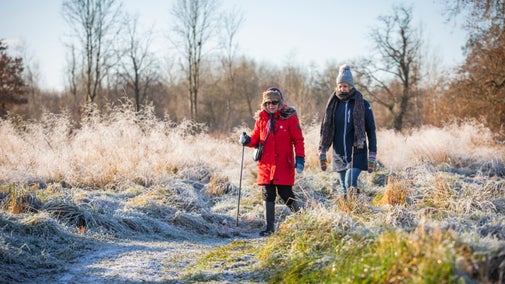Oxborough to Gooderstone heritage walk
Norfolk
Enjoy this gentle Norfolk walk, which takes in some of Breckland's protected farmland and heritage. Explore the pretty village of Oxborough, pass through Gooderstone with its Water Gardens and medieval church, and look out for the remains of Chalkrow Tower Mill.
Near to
Oxburgh EstateStart point
Oxburgh Hall car park. Grid ref: TF744014.Trail information
*Tracks and roads with no steep slopes. For further details, please see Terrain section.
**This route is not suitable for some people with reduced mobility. For further details, please see section marked Access.
***Dogs are welcome, under close control. For further details, please see section marked Facilities.
More near here
Blickling Estate walk
Explore the Blickling Estate's parkland on this family-friendly walk, visiting points of interest including the Tower, Brickyard and Mausoleum.

Burnham Overy Staithe walk
Enjoy a circular walk through Burnham Overy Staithe near Brancaster, soaking up the beautiful sights of the North Norfolk coast and its wildlife as well as local history.

Get in touch
Our partners

We’ve partnered with Cotswold Outdoor to help everyone make the most of their time outdoors in the places we care for.
Walking
Explore some of the finest landscapes in our care on coastal paths, accessible trails, woodland walks and everything in between. Find the best places to walk near you.

Walking in Norfolk
Discover the best walks around Norfolk, from a stroll around the estate at Blickling to a bracing trek on the Norfolk Coast Path.

Cotswold Outdoor: our exclusive walking partner
Learn about the National Trust’s ongoing partnership with Cotswold Outdoor. Find out how they help us care for precious places and the exclusive discount available for National Trust supporters.

Follow the Countryside Code
Help to look after National Trust places by observing a few simple guidelines during your visit and following the Countryside Code.

Staying safe at National Trust places
The special places in National Trust care sometimes come with a few risks for visitors, be it coastline or countryside. Find out how to keep safe throughout your visits.

Eating and shopping at Oxburgh Estate
Enjoy something to eat and drink in the Servants' Hall tea-room or the Pantry café during your visit. You'll also find our Courtyard Giftshop and the Potting Shed second-hand bookshop.

Explore the estate at Oxburgh
Oxburgh Estate is nestled on the edge of the Norfolk Brecks, where the land meets the wide-open Fenlands. Discover the wider parkland, and the wildlife that makes their home here.

Visiting Oxburgh Estate with your dog
Oxburgh Estate is a two pawprint rated place. To help everyone have a fantastic time when you visit with your dog, we ask that you follow this guidance.

